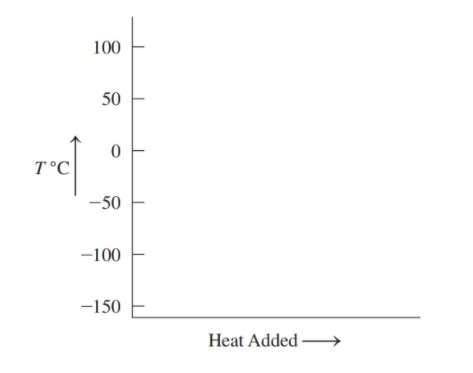
Concept explainers
Ethanol,
a. Draw a heating curve for ethanol from
b. When 20.0 g of ethanol at -62 °C is heated and completely vaporized at 78 °C, how much energy, in kilojoules, is required?
c. If a 15.0-gal gas tank is filled with E85, how many liters of ethanol are in the gas tank?
d. Write the balanced chemical equation for the complete combustion of ethanol.
e. How many kilograms of
f. What would be the strongest intermolecular force between liquid ethanol molecules?

Want to see the full answer?
Check out a sample textbook solution
Chapter 10 Solutions
EP BASIC CHEMISTRY-STANDALONE ACCESS
- Are changes in state physical or chemical changes? Explain. What type of forces must be overcome to melt or vaporize a substance (are these forces intramolecular or intermolecular)? Define the molar heat of fusion and molar heat of vaporization. Why is the molar heat of vaporization of water so much larger than its molar heat of fusion? Why does the boiling point of a liquid vary with altitude?arrow_forwardBenzene, C6H6, is an organic liquid that freezes at 5.5 C (Figure 11.1) to form beautiful, feather-like crystals. How much energy is evolved as heat when 15.5 g of benzene freezes at 5.5 C? (The enthalpy of fusion of benzene is 9.95 kJ/mol.) If the 15.5-g sample is remelted, again at 5.5 C, what quantity of energy is required to convert it to a liquid?arrow_forwardThe enthalpy change when 1 mol methane (CH4) is burned is 890 kJ. It takes 44.0 kJ to vaporize 1 mol water. What mass of methane must be burned to provide the heat needed to vaporize 1.00 g water?arrow_forward
- The cooling effect of alcohol on the skin is due to its evaporation. Calculate the heat of vaporization of ethanol (ethyl alcohol), C2H5OH. C2H5OH(l)C2H5OH(g);H=? The standard enthalpy of formation of C2H5OH(l) is 277.7 kJ/mol and that of C2H5OH(g) is 235.1 kJ/mol.arrow_forwardA quantity of ice at 0C is added to 64.3 g of water in a glass at 55C. After the ice melted, the temperature of the water in the glass was 15C. How much ice was added? The heat of fusion of water is 6.01 kJ/mol and the specific heat is 4.18 J/(g C).arrow_forwardWill a closed container of water at 70 C or an open container of water at the same temperature cool faster on a cold winter day? Explain why.arrow_forward
- The enthalpy of vaporization of water is larger than its enthalpy of fusion. Explain why.arrow_forward5-81 Compare the number of calories absorbed when 100. g of ice at 0°C is changed to liquid water at 37°C with the number of calories absorbed when 100. g of liquid water is warmed from 0°C to 37°C.arrow_forwardThe amount of heat required to melt 2 lbs of ice is twice the amount of heat required to melt 1 lb of ice. Is this observation a macroscopic or microscopic description of chemical behavior? Explain your answer.arrow_forward
- Evaporation of sweat requires energy and thus take excess heat away from the body. Some of the water that you drink may eventually be converted into sweat and evaporate. If you drink a 20-ounce bottle of water that had been in the refrigerator at 3.8 C, how much heat is needed to convert all of that water into sweat and then to vapor? (Note: Your body temperature is 36.6 oc. For the purpose of solving this problem, assume that the thermal properties of sweat are the same as for water.)arrow_forwardIf you want to convert 56.0 g ice (at 0 °C) to water at 75.0 °C, calculate how many grams of propane, C3H8, you would have to bum to supply the energy to melt the ice and then warm it to the final temperature (at 1 bar).arrow_forwardWhich requires the absorption of a greater amount of heat—vaporizing 100.0 g of benzene or boiling 20.0 g of water? (Use Table 8.2.)arrow_forward
 Chemistry & Chemical ReactivityChemistryISBN:9781133949640Author:John C. Kotz, Paul M. Treichel, John Townsend, David TreichelPublisher:Cengage Learning
Chemistry & Chemical ReactivityChemistryISBN:9781133949640Author:John C. Kotz, Paul M. Treichel, John Townsend, David TreichelPublisher:Cengage Learning Chemistry & Chemical ReactivityChemistryISBN:9781337399074Author:John C. Kotz, Paul M. Treichel, John Townsend, David TreichelPublisher:Cengage Learning
Chemistry & Chemical ReactivityChemistryISBN:9781337399074Author:John C. Kotz, Paul M. Treichel, John Townsend, David TreichelPublisher:Cengage Learning Chemistry: The Molecular ScienceChemistryISBN:9781285199047Author:John W. Moore, Conrad L. StanitskiPublisher:Cengage Learning
Chemistry: The Molecular ScienceChemistryISBN:9781285199047Author:John W. Moore, Conrad L. StanitskiPublisher:Cengage Learning Chemistry for Engineering StudentsChemistryISBN:9781337398909Author:Lawrence S. Brown, Tom HolmePublisher:Cengage Learning
Chemistry for Engineering StudentsChemistryISBN:9781337398909Author:Lawrence S. Brown, Tom HolmePublisher:Cengage Learning Chemistry: Principles and PracticeChemistryISBN:9780534420123Author:Daniel L. Reger, Scott R. Goode, David W. Ball, Edward MercerPublisher:Cengage Learning
Chemistry: Principles and PracticeChemistryISBN:9780534420123Author:Daniel L. Reger, Scott R. Goode, David W. Ball, Edward MercerPublisher:Cengage Learning Chemistry by OpenStax (2015-05-04)ChemistryISBN:9781938168390Author:Klaus Theopold, Richard H Langley, Paul Flowers, William R. Robinson, Mark BlaserPublisher:OpenStax
Chemistry by OpenStax (2015-05-04)ChemistryISBN:9781938168390Author:Klaus Theopold, Richard H Langley, Paul Flowers, William R. Robinson, Mark BlaserPublisher:OpenStax





